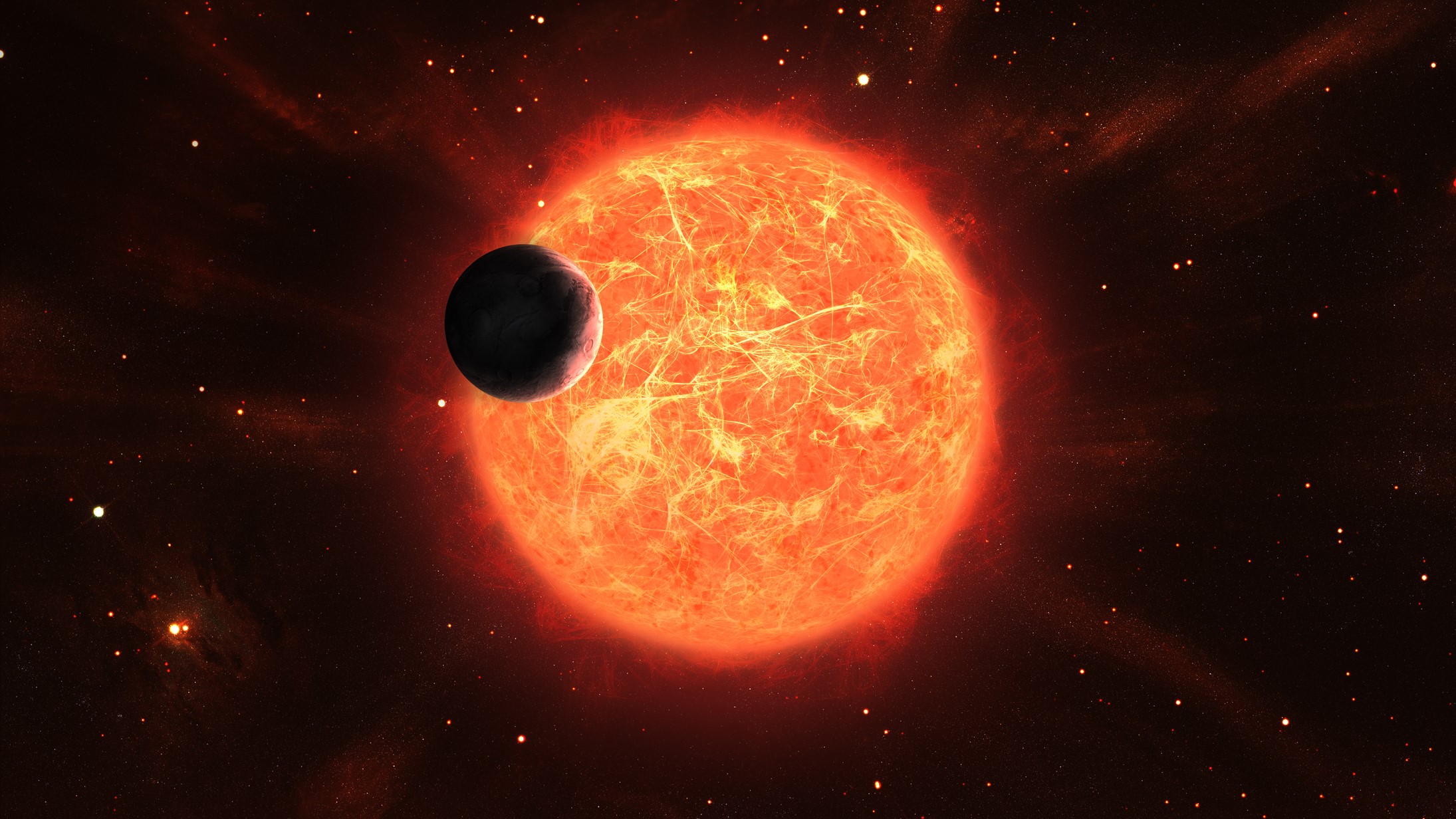Red giant stars: Facts, definition & the future of the sun
Our sun will become a red giant in about five billion years.

A red giant is a dying star in the final stages of stellar evolution.
In about five billion years, our own sun will turn into a red giant, expand and engulf the inner planets — including Earth.
What does the future hold for the light of our solar system and others like it?
Related: Will our solar system survive the death of our sun?
Red giant star formation
Most of the stars in the universe are main sequence stars — those that convert hydrogen into helium in their cores via nuclear fusion.
Over the course of their "normal" lives, the outward pressure of fusion inside main sequence stars balances out the inward pressure of gravity. Once the core fusion stops, however, gravity takes over and begins compressing the star.
"This raises the internal temperature of the star and ignites a shell of hydrogen burning around the inert core," Swinburne University of Technology in Australia wrote in a stellar evolution explainer.
Breaking space news, the latest updates on rocket launches, skywatching events and more!
"Meanwhile, the helium core continues to contract and increase in temperature, which leads to an increased energy generation rate in the hydrogen shell," the explainer continues. "This causes the star to expand enormously and increase in luminosity — the star becomes a red giant."
Red giant size and temperature
Red giant stars bloat to 62 million to 620 million miles in diameter (100 million to 1 billion kilometers) — 100 to 1,000 times wider than our sun is today. Because these stars' energy is spread across such a large area, their surface temperatures are actually relatively cool, reaching only 4,000 to 5,800 degrees Fahrenheit (2,200 to 3,200 degrees Celsius), a little over half as hot as the sun. This temperature change causes stars to shine in the redder part of the spectrum, leading to the name "red giant," though they are often more orangish in appearance.
Red giants' core temperatures, however, continue to rise as the core contracts further, eventually reaching levels where helium fuses to form carbon. (This is known as the "triple alpha process" because it involves three helium-4 isotopes or alpha particles.) If the star is at least 2.2 times more massive than our sun, helium-to-carbon ignition is a relatively gradual process. But for less hefty stars, it occurs with an explosive flash.
Eventually, the helium in the core runs out and fusion stops. The core shrinks again and a helium shell just beyond it ignites, as happened with hydrogen shortly after the star burned through its stores of that initial fuel.
This ignition causes the giant's outer layers to expand even further, but its core continues to collapse in on itself. The star eventually becomes incredibly compact, turning into a superdense object known as a white dwarf. Around the time of this transition, the star ejects its outer layers in huge clouds of gas and dust known as planetary nebulae. (The misleading name was given by early astronomers, who thought these sky sights looked like planets.) These shells are much larger and fainter than their parent stars.
After spending about 1 billion years as a red giant, our own sun will become a white dwarf, packing most of its initial mass into a sphere roughly the size of Earth. This fate awaits many other stars as well — all of them that are less than about eight times more massive than the sun, in fact.
The end-of-life scenario for giant stars is different. Stars roughly eight to 40 times more massive than the sun, for example, go through a "red supergiant" phase. Their cores get hot enough to burn carbon, which our sun never will, and they eventually die in powerful supernova explosions. When it's all said and done, these massive stars leave behind either a neutron star or a black hole.
And this all happens quite quickly, cosmically speaking, because huge stars burn through their fuel very fast. For example, while our sun will end up fusing hydrogen in its core for about 10 billion years, stars that become red supergiants exhaust their reserves in just 10 million years or so. And they march through the other late-life steps even faster than that.
Some of the brightest and best-known stars in the night sky are red supergiants. Betelgeuse, which forms the shoulder of the constellation Orion (The Hunter), is a red supergiant. So is Antares, the brightest star in the constellation Scorpius.
Related: Amazing photos of supernova explosions
The future of the sun
In approximately five billion years, our own sun will transition to the red giant phase. When it expands, its outer layers will consume Mercury and Venus and also reach Earth. Scientists are still debating whether or not our planet will be engulfed, or whether it will orbit dangerously close to the red giant sun. Either way, life, as we know it on Earth, will cease to exist.
Related: When will the sun die?
In fact, surface life on our planet will likely be wiped out long before the sun turns into a red giant. Our star has been getting warmer over the eons, as main-sequence stars of its mass do, and in a few hundred million years, it will be hot enough to start evaporating the oceans. So there may not be much left for our bloated, red-giant sun to destroy.
"The future of the Earth is to die with the sun boiling up the oceans, but the hot rock will survive," astrophysicist Don Kurtz, of the University of Lancashire, told Reuters.
Our changing sun may provide hope to other planets, however. When a star morphs into a red giant, it changes its home system's "habitable zone," the range of orbital distance where liquid water can exist on a world's surface. Because a star remains a red giant for approximately a billion years, it may be possible for life to arise on distantly orbiting planets and moons, which will finally receive some warmth.
"When a star ages and brightens, the habitable zone moves outward, and you're basically giving a second wind to a planetary system," exoplanet scientist Ramses M. Ramirez, a researcher at Cornell University's Carl Sagan Institute, said in a statement. "Currently objects in these outer regions are frozen in our own solar system, like Europa and Enceladus — moons orbiting Jupiter and Saturn."
The window of opportunity will be open only briefly, however. When the sun and other smaller stars shrink back down to white dwarfs, the life-giving light will dissipate. And supernovae from larger stars could present other habitability issues.
Red giant stars Q&A with an expert
We asked Sarafina El-Badry Nance, Berkeley astrophysicist and author, a few frequently asked questions about red giant stars.
Sarafina El-Badry Nance is an astrophysicist and Ph.D. candidate at UC Berkeley and Lawrence Berkeley National Lab researching supernovas and computational cosmology. She is the author of Dutton's newly-released memoir, STARSTRUCK: A Memoir of Astrophysics and Finding Light in the Dark.
What are red giant stars?
Red giant stars (RSGs) are bright, bloated, low-to-medium mass stars approaching the ends of their lives. Nuclear fusion is the lifeblood of stars; they undergo nuclear fusion within their stellar cores to exert a pressure counteracting the inward force of gravity.
Stars fuse progressively heavier and heavier elements throughout their lives. From the outset, stars fuse hydrogen to helium, but once stars that will form RSGs exhaust hydrogen, they're unable to counteract the force of gravity. Instead, their helium core begins to collapse at the same time as surrounding hydrogen shells re-ignite, puffing out the star with sky-rocketing temperatures and creating an extraordinarily luminous, rapidly bloating star. As the star's outer envelope cools, it reddens, forming what we dub a "red giant".
What does a red giant star turn into?
As the bloated, dying star expels gas as it expands, the core recedes back in on itself, until it ultimately fizzles out and becomes a white dwarf. The gas surrounding the white dwarf continues to glow, creating a planetary nebula that houses a white dwarf at its center.
What is an example of a red giant star?
A few examples of RSGs include Aldebaran, Arcturus, and Mira. Planetary nebulae, however, can be much more astonishing for the casual stargazer to observe, such as the Cat's Eye Nebula, the Little Dumbbell Nebula, and NGC 2438.
Will the sun become a red giant?
The fate of our sun exemplifies the evolution of RSGs. Our sun will become a red giant near the end of its life — in five billion years or so — growing so large that it will engulf the inner planets and even Earth itself. Then, the gently expelled outer layers will form a glowing planetary nebula surrounding the fizzled out core — a white dwarf.
Additional resources
You can find good introductions to the basics of stellar evolution at this Swinburne University of Technology page and from NASA here. To learn more about red giants in particular, check out this lecture posted by the University of Oregon. And NASA's exoplanet site has a nice summary of what will happen in our solar system when the sun becomes a red giant.
Bibliography
- Jastrow, Robert. "Red giants and white dwarfs: The evolution of stars, planets, and life," Harper and Row, 1967. https://www.amazon.com/Red-giants-white-dwarfs-evolution/dp/B0006BO9H8
- Landau, Elizabeth. "Life and death of a planetary system." https://exoplanets.nasa.gov/life-and-death/intro/
- NASA, "The life cycles of stars: How supernovae are formed." https://imagine.gsfc.nasa.gov/educators/lessons/xray_spectra/background-lifecycles.html
- Vlemmings, Wouter et al. "The shock-heated atmosphere of an asymptotic giant branch star resolved by ALMA," Nature Astronomy 1, 848–853 (2017). https://www.nature.com/articles/s41550-017-0288-9
Follow Nola Taylor Redd at @NolaTRedd or on Facebook. Follow us at @Spacedotcom or on Facebook.
Join our Space Forums to keep talking space on the latest missions, night sky and more! And if you have a news tip, correction or comment, let us know at: community@space.com.

Nola Taylor Tillman is a contributing writer for Space.com. She loves all things space and astronomy-related, and always wants to learn more. She has a Bachelor's degree in English and Astrophysics from Agnes Scott College and served as an intern at Sky & Telescope magazine. She loves to speak to groups on astronomy-related subjects. She lives with her husband in Atlanta, Georgia. Follow her on Bluesky at @astrowriter.social.bluesky
